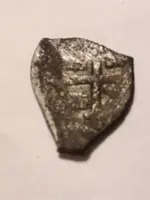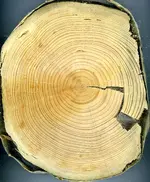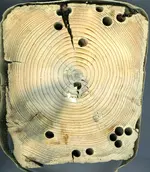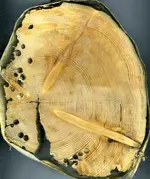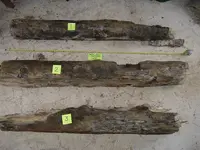TRG
Full Member
"Elementary my dear Watson"
Sleuthing
My interest in the above timber, especially initially, was to see how much could be learned from it given the very limited information available - evidence from the object itself and from the information on the attached card. I knew nothing about 17th century shipwrecks on the coast of Florida.
The timber is oak, well preserved, with two rows of nails (heads sheared off) showing (blue green) copper staining around them and some with whitish oxidation, assumed to be lead, surrounding. A ~3cm hole had been drilled at one side and at the broken end evidence of a square spike being driven through, again with blue-green copper stain surrounding. The one end of the timber has been violently broken as if from impact. Some shipworm damage, some barnacles attached, one side clean, the other pitted and decayed.
Hardware is consistent with 17th century ship construction as noted in "Ships' Fastenings; From Sewn Boat to Steamship" by Michael McCarthy, Texas A&M Press, 2005. Copper alloy nails fastening lead sheathing to hull planks fastened to frame with treenails and copper alloy spikes. Peter Earle's "The Treasure of the Concepción" notes repairs to that ship in Vera Cruz using lead sheathing.
State of preservation indicates long burial in sand and thus protected from shipworm. Barnacles indicate being exposed in near shore location - inter-tidal zone to ~30m depth. Not so many (barnacles) so exposure was not lengthy. One side was up (exposed to sand scour), the other partially buried.
Just over 120 rings are visible in cross section, nice variability. Suitable for tree ring dating. Base chronologies are available from eastern North America and Europe including the Basque region of Spain where oak was harvested for shipbuilding during this time. Strong match with German oak is reasonable as timber was being purchased from this region by Spain for ship building during the 17th century. Outer ring date 1586, no sapwood. Missing sapwood = 15-30 years, so minimum date of felling = post 1600 AD. Typical timber usage relies on utilization with relatively little trimming - pick a tree about the right size for intended use. This tree has been split to yield 2 planks - seems reasonable. Missing heartwood rings probably <50. Likely felling date before 1650.
Information card gives a very general location (Boca Raton), a date of acquisition (1966), and an accessory fact "1640 coin".
No information is given about said coin - one or many? how dated? clearly associated with a wreck site? That said it will be assumed to be"good information" with acknowledgement that this is indeed an assumption that cannot be proved without additional evidence.
In 1964 Hurricane Cleo swept up the east coast of Florida:
Storm Tracks by Name: Hurricane Cleo, 1964
Following the storm some finds were made along the coast including 18th century cannon. Possibly a wreck site or bits of a wreck were exposed near Boca Raton and found not too long after - barnacles, but not too many, well preserved wood exposed after long burial. This is speculation that seems reasonable.
For the following discussion remember that the wreck of the Concepción was not relocated until 1978. The disaster was well known, especially because of Phips successful salvage in 1687, but any coinage of that vintage turning up on the east coast should logically have come from the initial wrecks or from circulation of salvaged coins post 1687.
The plate fleet of 1641 is an obvious source for coinage deemed to be "1640" in vintage. Many ships were wrecked/driven ashore on/near the Florida coast. Problem - as CHAGY noted up thread testimony of a/the survivor(s) put the disaster occurring near 30 deg N lat. Boca Raton is ~26 deg N and an error of 4 degrees seems a bit of a stretch. Without a concerted research effort in Seville it is not possible to form a more complete opinion about this testimony. Could ships have gone ashore after being driven south? Winds and currents make this seem unlikely... not impossible but unlikely, so either the testimony is in error or misleading in some fashion or the timber in question is from some other source. If the coin date is to be taken as correct and the latest felling date for timber 1650 (effective lifespan of ships ~<30yrs) then there are a few possibilities using Steve Singer's "Shipwrecks of Florida" as a source. However most in the Boca Raton area either pre-date the coin or post date it considerably.
Not resolvable without more evidence and more research.
CHAGY lists 6 ships from the 1641 fleet possible ending up on the Florida coast and 4 others accounted for. If the escort of 9 is assumed to have all survived that leaves an additional 11 ships unaccounted for. Hmmm.
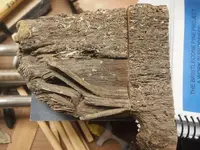
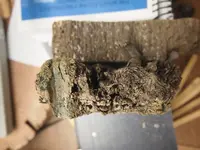
Sleuthing
My interest in the above timber, especially initially, was to see how much could be learned from it given the very limited information available - evidence from the object itself and from the information on the attached card. I knew nothing about 17th century shipwrecks on the coast of Florida.
The timber is oak, well preserved, with two rows of nails (heads sheared off) showing (blue green) copper staining around them and some with whitish oxidation, assumed to be lead, surrounding. A ~3cm hole had been drilled at one side and at the broken end evidence of a square spike being driven through, again with blue-green copper stain surrounding. The one end of the timber has been violently broken as if from impact. Some shipworm damage, some barnacles attached, one side clean, the other pitted and decayed.
Hardware is consistent with 17th century ship construction as noted in "Ships' Fastenings; From Sewn Boat to Steamship" by Michael McCarthy, Texas A&M Press, 2005. Copper alloy nails fastening lead sheathing to hull planks fastened to frame with treenails and copper alloy spikes. Peter Earle's "The Treasure of the Concepción" notes repairs to that ship in Vera Cruz using lead sheathing.
State of preservation indicates long burial in sand and thus protected from shipworm. Barnacles indicate being exposed in near shore location - inter-tidal zone to ~30m depth. Not so many (barnacles) so exposure was not lengthy. One side was up (exposed to sand scour), the other partially buried.
Just over 120 rings are visible in cross section, nice variability. Suitable for tree ring dating. Base chronologies are available from eastern North America and Europe including the Basque region of Spain where oak was harvested for shipbuilding during this time. Strong match with German oak is reasonable as timber was being purchased from this region by Spain for ship building during the 17th century. Outer ring date 1586, no sapwood. Missing sapwood = 15-30 years, so minimum date of felling = post 1600 AD. Typical timber usage relies on utilization with relatively little trimming - pick a tree about the right size for intended use. This tree has been split to yield 2 planks - seems reasonable. Missing heartwood rings probably <50. Likely felling date before 1650.
Information card gives a very general location (Boca Raton), a date of acquisition (1966), and an accessory fact "1640 coin".
No information is given about said coin - one or many? how dated? clearly associated with a wreck site? That said it will be assumed to be"good information" with acknowledgement that this is indeed an assumption that cannot be proved without additional evidence.
In 1964 Hurricane Cleo swept up the east coast of Florida:
Storm Tracks by Name: Hurricane Cleo, 1964
Following the storm some finds were made along the coast including 18th century cannon. Possibly a wreck site or bits of a wreck were exposed near Boca Raton and found not too long after - barnacles, but not too many, well preserved wood exposed after long burial. This is speculation that seems reasonable.
For the following discussion remember that the wreck of the Concepción was not relocated until 1978. The disaster was well known, especially because of Phips successful salvage in 1687, but any coinage of that vintage turning up on the east coast should logically have come from the initial wrecks or from circulation of salvaged coins post 1687.
The plate fleet of 1641 is an obvious source for coinage deemed to be "1640" in vintage. Many ships were wrecked/driven ashore on/near the Florida coast. Problem - as CHAGY noted up thread testimony of a/the survivor(s) put the disaster occurring near 30 deg N lat. Boca Raton is ~26 deg N and an error of 4 degrees seems a bit of a stretch. Without a concerted research effort in Seville it is not possible to form a more complete opinion about this testimony. Could ships have gone ashore after being driven south? Winds and currents make this seem unlikely... not impossible but unlikely, so either the testimony is in error or misleading in some fashion or the timber in question is from some other source. If the coin date is to be taken as correct and the latest felling date for timber 1650 (effective lifespan of ships ~<30yrs) then there are a few possibilities using Steve Singer's "Shipwrecks of Florida" as a source. However most in the Boca Raton area either pre-date the coin or post date it considerably.
Not resolvable without more evidence and more research.
CHAGY lists 6 ships from the 1641 fleet possible ending up on the Florida coast and 4 others accounted for. If the escort of 9 is assumed to have all survived that leaves an additional 11 ships unaccounted for. Hmmm.





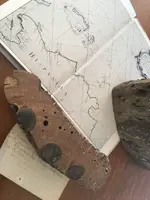
 )
)